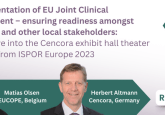Multistakeholder perspectives on preparing for EU HTA – ensuring stakeholder alignment to accelerate broad patient access

With the European Health Technology Assessment (HTA) Regulation in Europe coming into force in January 2025, there is much speculation around its implications for streamlining market access, as well as the practicalities of implementing such a large-scale initiative across the EU. The publication of the first draft implementing act, providing the procedural rules, timelines and templates for the coordinated assessment of medicinal products, has offered some insight on the process, but key questions remain about resource allocation, timelines, methodologies and potential challenges in achieving true harmonization.
As stakeholders grapple with these challenges, EU HTA has become a hot topic of conversation. Here, we summarize the discussion from the Cencora-sponsored session, ‘EU HTA: how to ensure stakeholder alignment on a national level to accelerate broad patient access’, which took place at the World Evidence, Pricing and Access Congress 2024, March 12–13, 2024; Amsterdam, The Netherlands.

The session, drawing a standing-room-only crowd, brought together leading experts in market access including the moderator Herbert Altmann (Vice President, Pan European Market Access and Healthcare Consulting, Cencora) and panelists Mihai Rotaru (Director, Market Access, EFPIA), Neil Grubert (Independent Global Market Access Consultant) and Casper Paardekooper (Partner, Vintura, Part of Cencora). The discussion centered on challenges with the new EU HTA Regulation and joint clinical assessment (JCA) process in particular; specifically, its workload and limited engagement with industry during its development. Concerns were raised about the impact on smaller companies and the overall attractiveness of Europe for investment in healthcare innovation. The panel agreed that companies need to prepare for the JCA by adapting their operations and engaging with local stakeholders.
Now that the first implementing act has been published, how do you feel this will impact the adaptation of national HTA procedures in the largest markets in Europe?
Neil Grubert addressed the first question from Herbert Altmann by explaining that, in his opinion, the implementing act was unfortunately broadly in line with expectations but with some surprises in terms of the “potentially onerous” volume of data requirements. Grubert noted the potential impact of JCA presents a paradox: JCA requires a significant change to national procedures for all stakeholders, including industry and HTA agencies, but only covers a limited proportion of the HTA process. The original goal of JCA was to reduce overall workload; however, the concern is that it might have the opposite effect particularly as the process will be needed for all new oncology and ATMP drugs.
Grubert noted the tight, almost “unrealistic”, deadlines outlined within the implementing act that could become even more challenging alongside the shortened marketing authorization timelines proposed under the forthcoming revision of the EU general pharmaceutical legislation (GPL). Delays in the publication of the other implementing acts, with the last act not due to come out until Q4 of 2024, means there is limited time to prepare, which presents further challenges.
On a national level, Grubert noted “lots of moving parts”, with several HTA changes underway, including new legislation to reform Spain’s HTA system and reorganization by AIFA in Italy. He noted that Germany and France are expected to do most of the “heavy lifting” in terms of preparing the JCA reports. Having been previously reticent about the idea of joint HTA in Europe, with the JCA template closely resembling Germany’s AMNOG dossier template, the country is probably more welcoming towards the process. Of interest, Grubert highlighted a recent interview with Germany’s IQWiG Director, Thomas Kaiser, who raised the issue of whether his agency would compile JCA reports in English or work in German and then translate to English, which would add to the complexity.
How do you foresee the collaboration between EFPIA and HTA agencies to ensure successful implementation of the regulation? What do you consider to be the key factors for this collaboration to be successful?

Speaking on behalf of industry, Mihai Rotaru explained the general feeling of a limited, “quasi non-existent”, collaboration so far between companies and HTA bodies in respect to defining the EU process, despite a detailed mechanism for stakeholder consultation being included in the EUNetHTA21 project plan. With less than 10 months until implementation, companies have limited time to prepare but, “they don’t know what to prepare for.” Questions remain in terms of methodologies and detailed procedures coming from the Member State Coordination Group on HTA (HTACG), who will be defining around 80–85% of the JCA process. Rotaru welcomed the feedback opportunities on the implementation acts and questioned whether stakeholders would have a similar avenue to provide feedback on the work of the HTACG.
What do you hear from small and medium-sized companies? How do they prepare?
Casper Paardekooper acknowledged that, like bigger companies, small and medium-sized companies are preparing as much as they can for the EU regulation but there are many potential hurdles. With global or European headquarters, not all small and medium-sized companies have a local affiliate within each European country. This presents difficulties in terms of the data requirements, particularly in terms of local epidemiological data and insights into clinical pathways, a requirement specified in the first implementation act. The lack of “feet on the ground” also presents a problem for the local HTA discussions following JCA, which are difficult to coordinate from a global or European headquarter perspective. Small and medium-sized companies also have smaller teams and may struggle to absorb the significant additional workload associated with the JCA process.
Despite these challenges, Paardekooper noted the leaner, more agile approach from smaller companies had its advantages as they and their cross-functional teams could respond more quickly to the changing situation. Working with industry associations, like EFPIA and EUCOPE, and external experts to keep pace with the legislation and address any gaps in internal capacity or knowledge might also be the solution.
Will the EU HTAR make Europe an attractive place for healthcare innovators to invest?
As explained by Herbert Altmann, one of the goals of joint HTA was to foster investment by the pharmaceutical industry in Europe. Neil Grubert explained that despite initial optimism, this has now waned as industry has had “very limited” involvement in shaping the process overall and making contributions to the scoping of the assessments of individual products. Grubert stressed that joint HTA needs to be viewed in the context of the broader ambitions of the EU pharmaceutical strategy and proposed revisions to the general pharmaceutical legislation, which could make the environment even more challenging from an industry perspective. For instance, the proposed reduction in regulatory data protection from 8 to 7.5 years, with a potential 2-year extension for companies launching drugs in all EU countries within 2 years of authorization, seems challenging to achieve. This raises concerns about the timeliness of JCA reports.
“You’re going to have the JCA report published within potentially weeks of marketing authorization. Even if companies do their best to adhere to those proposed timelines, if you have countries where you’re not going to launch until near the end of that 2-year window, what will have happened in that time? And, will that JCA report still be timely or will some of that content have become obsolete?”
From Grubert’s perspective, it is unclear whether this will enhance the attractiveness of the industry compared with other regions, such a China and Asia-Pacific, who will be looking to gain ground over the next 10–20 years. Grubert closed by asking whether Europe would, “enhance its position or risk losing ground in the next decade and beyond.”
Mihai Rotaru noted that, from EFPIA’s perspective, European-based pharmaceutical manufacturers are still very committed to innovate and to provide these innovations to European patients. However, he indicated some misgivings with EU HTA that it is, “not going in the direction of making things easier.” He also stressed there were several “warning signs” with the information being issued so far. The only way to really make JCA work in Europe is through harmonization, particularly with regards to how the evidence is developed and the associated PICOs (patient population, intervention, comparison and outcomes).
“The one clear way where the EU can use the JCA as an opportunity to become more attractive is if they speak with one voice. There is an opportunity and there are two important mechanisms in the HTA regulation – the scientific advice piece and the clinical assessment piece – where if there is a true effort from 27 member states to speak with one voice… they could have a direct impact on global clinical development plans… The impact that Europe could have by speaking with a more streamlined voice could be enormous.”
Altmann also advocated for a unified European voice and highlighted a point from previous discussions during the congress that the early involvement of market access functions to drive clinical trial design is key to develop the evidence needed for a successful HTA assessment as well as the following pricing and reimbursement process.
Working with many pharma companies on the topic, how can they prepare? What is their biggest challenge and what do you recommend they do to manage all these uncertainties?
Casper Paardekooper reiterated the importance of pharma companies preparing for the implementation of EU HTA in terms of new operating models and cross-functional teams. Companies must internally align with local affiliates to engage with local stakeholders.
“I think it’s crucial that we have one European voice and I think that’s a message that needs to be repeated on a local level as much as possible, because that’s where the questions will be coming from. Don’t only focus on your European or your global organization – focus on what you can do locally as well to support your country affiliates and their local industry associations… to limit the amount of PICOs that we will get.”
Altmann ended the session by adding the need for local-level education, particularly in the smaller countries with ATMPs and oncology drugs being the first to be assessed under the JCA process. Especially in some smaller counties there may be very limited knowledge about latest ATMP innovations, which will make it more difficult for such HTAb to give qualified feedback in this JCA process.
About the speakers

Herbert Altmann
Vice President, Pan European Market Access and Healthcare Consulting, Cencora
Herbert Altmann leads the European Market Access department, working with pharmaceutical companies bringing innovative medicines to patients as fast as possible. Before joining Cencora in February 2023, Altmann worked at Novartis for more than 10 years, serving as the Head of Value & Access Region Europe. Altmann also was a NVS representative on the EFPIA HTA working group, participating in two Joint Action 3 pilot assessments.

Mihai Rotaru
Director Market Access at EFPIA – European Federation of Pharmaceutical Industries and Associations
Mihai Rotaru works as a Director Market Access at EFPIA (European Federation of Pharmaceutical Industries and Associations) where he is currently responsible for overall industry engagement in the implementation of the HTA Regulation at EU level. In addition, Mihai is also responsible for oncology policy, biotherapeutics as well as various supply chain issues (Falsified Medicines Directive, shortages and anticounterfeiting efforts).

Neil Grubert
Independent Global Market Access Consultant
Neil Grubert is a pharmaceutical market access specialist with more than 20 years of experience tracking access environments around the world. He advises leading biopharmaceutical companies on the implications of international access trends and has authored more than 150 reports on the subject. Neil also delivers multi-client and bespoke training programs.

Casper Paardekooper
Partner, Vintura, Part of Cencora
Casper Paardekooper operates in the Life Sciences practice and is responsible for Vintura’s Value, Access & Policy Center of Excellence. In that capacity, he focuses on access policy, market access strategy, value demonstration and value-based health care.
Sponsorship for this Deep Dive was provided by Cencora.






